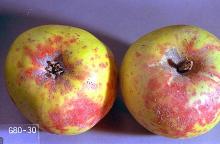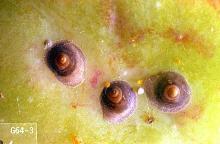European fruit lecanium (Parthenolecanium corni)
San Jose scale (Quadraspidiotus perniciosus)
Pest description and crop damage Lecanium scales are up to 0.2 inch across, reddish brown, and rounded, resembling small helmets or bumps on branches, stems, and the underside of leaves. The immature "crawlers" are flat, oval, and pinkish brown. San Jose scale is less than 0.1 inch in length and has a tiny white knob in the center with a series of grooves or rings around it. Severe infestations can kill twigs. Large quantities of honeydew are produced, which makes leaves and fruit beneath the scale infestation shiny and sticky. Sooty mold fungus may grow on this, giving the plants a dirty, sooty appearance.
Biology and life history Lecanium scale overwinters as an immature scale on twigs and branches. They resume feeding in the spring, and eggs are laid underneath the scales in May to June. The eggs remain under the scales until hatching in early summer. The young scales, called "crawlers," migrate to the undersides of leaves to feed. Young scales can be dispersed by wind, rain, irrigation, or by the movement of people and machinery. After four to six weeks on the leaves, the young return to the stems and twigs to feed, mate, and overwinter. There is one generation per year.
San Jose scale overwinters as immature scales and are black in color. In spring, the tiny, winged males emerge and mate with wingless females. The immature crawlers are very small, flattened, and yellow, and move around on bark and foliage before settling down to feed. Young scales can be dispersed by wind, rain, irrigation, or by the movement of people and machinery. A few days later, they secrete a waxy coating over their body that protects them from pesticides; therefore, time pesticide applications when crawler populations are present. From this point, female scales do not move. Crawlers appear during June and July and again in August to September, so there are two generations per year.
Pest monitoring Inspect twigs during the dormant season for scales. Pay attention to weak plants. The crawlers are best observed during May to July with a 10X magnifying lens. Crawlers can be monitored by wrapping a piece of black sticky tape around an infested branch with the sticky side out.
Management-biological control
Larvae of green lacewings, lady beetles, and other insects are aggressive predators of scale.
Management-cultural control
Home Orchardists: Scale can be rubbed off plants by hand with a glove or toothbrush. Major infestations can be pruned off. Non-toxic adhesive materials can be applied around infestations of adult scales to catch the crawler stage. As with aphids, avoid excessive nitrogen fertilizer or water applications, as these favor increases in scale populations.
Management-chemical control: HOME USE
Dormant-season spray
Apply only during dormant or delayed-dormant period. Use enough water to cover all the tree thoroughly including small limbs and shoots.
- horticultural mineral oil-Some formulations are OMRI-listed for organic use.
Growing-season spray
- azadirachtin (neem oil)-Some formulations are OMRI-listed for organic use.
- carbaryl-Highly toxic to bees.
- gamma-cyhalothrin-Highly toxic to bees.
- horticultural mineral oil-Some formulations OMRI-listed for organic use.
- imidacloprid-Plum only. Soil drenches may have residual activity in woody plants lasting for 12 or more months. If short-term management is the goal, consider other approaches.
- insecticidal soap-Some formulations OMRI-listed for organic use.
- lambda-cyhalothrin-Highly toxic to bees.
- plant-derived essential oils-Some have shown efficacy against scale. Some formulations are OMRI-listed for organic use.
- pyrethrins (often as a mix with other ingredients)- Highly toxic to bees. Some formulations are OMRI-listed for organic use.
- zeta-cypermethrin-Highly toxic to bees.
Management-chemical control: COMMERCIAL USE
Dormant to delayed-dormant spray
If lecanium scale is the main problem, dormant oil sprays are most effective. If San Jose scale is the main problem, use oil plus diazinon.
- diazinon (Diazinon 50W) at 3 to 4 lb/A (1 lb/100 gal minimum). REI 4 days. PHI 21 days. Apply as a dormant spray. When using spray oils, follow spray oil manufacturer's use directions. Do not apply more than 4 lb product or 6 gal oil per acre. If applied in late April or May, mix diazinon with 1 gal of light to medium summer horticultural oil per 100 gal water. Do not exceed one dormant application of diazinon per growing season.
- horticultural mineral oil (rates vary; check product label)-Use oil at the highest concentration only in the dormant period. REI varies; check product label. Some formulations are OMRI-listed for organic use.
- pyriproxyfen (Esteem 35 WP) at 4 to 5 oz/A + horticultural mineral oil (rates vary; check product label). REI 12 hr.
Spring and summer spray
If delayed-dormant spray has not been applied, then a summer spray will effectively control scale in the crawler stage. Summer spray is directed at those crawlers that appear in late June, mid-July, and September.
- buprofezin (Centaur WDG) at 34.5 oz/A. REI 12 hr. PHI 14 days. Do not exceed two applications per season.
- diazinon (Diazinon 50W) at 1 lb/100 gal water (4 lb/A). REI 4 days. PHI 21 days. Apply as a dormant spray. When using spray oils, follow spray oil manufacturer's use directions. Do not apply more than 4 lb product or 6 gal oil per acre. If applied in late April or May, mix diazinon with 1 gal of light to- medium summer horticultural oil per 100 gal water. Do not exceed one in-season application per growing season.
- phosmet (Imidan 70W) at 2.13 to 4.25 lbs/A. REI 7 days. PHI 7 days.
- pyriproxyfen (Esteem 35WP) at 4 to 5 oz/A. REI 12 hr. PHI 14 days.
- spirotetramat (Movento, Ultor)-Product formulations vary, check label for rates. REI 24 hr. PHI 7 days. Under heavy scale infestation pressure or where difficult control conditions exist, a second application may be necessary.



